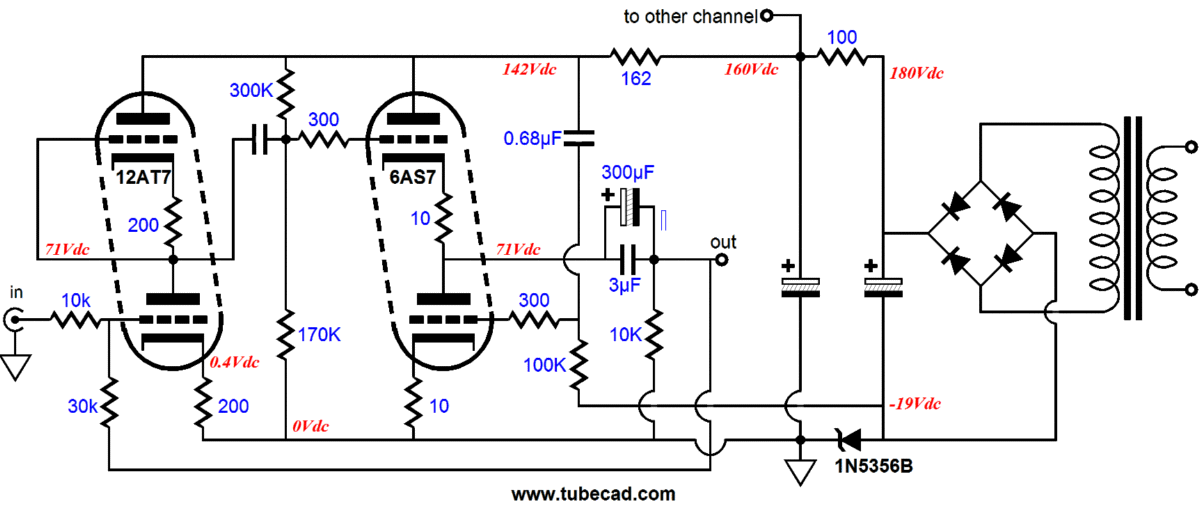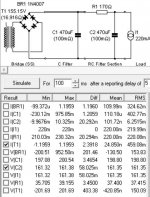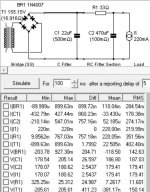Hello,
I am looking into building an OTL tube headphone amplifier based on the Aikido Push-Pull circuit. The headphones that I'd like to drive (HE-400S) are low impedance at 32 ohms, so I am looking at building the 6AS7 based design that is covered.
The design seems straightforward enough, however trying to design the power supply needed for this has been tricky. According to the schematic, I need a B+ of 160 Vdc. From the datasheets for the tubes, the sum of all the plate currents is 220 mA (100 mA for each 6AS7, 0.3 mA for each 12AT7), and the sum of the filament currents is 5.6 A. I'm having trouble finding a power transformer that fits the above requirements without having too much voltage. I think I have a suitable candidate in the Hammond 369KX, which provides 450 V C.T. @ 300mA, with a 6.3 V C.T. winding @ 6 A. It also has a bias tap at 50 V which I can use to provide the -19 V fixed bias for the 6AS7.
My question is, did I use the right numbers from the schematic for sizing the power transformer, and if not what should I look for to do so? Another question is getting 160 Vdc from this power transformer, I think I can just use half the winding to get 225 Vac, rectify it, and use the filtering stage to drop it down to what I need.
Any pointers or links on figuring out this stuff would be greatly appreciated, thank you!
I am looking into building an OTL tube headphone amplifier based on the Aikido Push-Pull circuit. The headphones that I'd like to drive (HE-400S) are low impedance at 32 ohms, so I am looking at building the 6AS7 based design that is covered.
The design seems straightforward enough, however trying to design the power supply needed for this has been tricky. According to the schematic, I need a B+ of 160 Vdc. From the datasheets for the tubes, the sum of all the plate currents is 220 mA (100 mA for each 6AS7, 0.3 mA for each 12AT7), and the sum of the filament currents is 5.6 A. I'm having trouble finding a power transformer that fits the above requirements without having too much voltage. I think I have a suitable candidate in the Hammond 369KX, which provides 450 V C.T. @ 300mA, with a 6.3 V C.T. winding @ 6 A. It also has a bias tap at 50 V which I can use to provide the -19 V fixed bias for the 6AS7.
My question is, did I use the right numbers from the schematic for sizing the power transformer, and if not what should I look for to do so? Another question is getting 160 Vdc from this power transformer, I think I can just use half the winding to get 225 Vac, rectify it, and use the filtering stage to drop it down to what I need.
Any pointers or links on figuring out this stuff would be greatly appreciated, thank you!
I am interested in this schematic, either.
However, I found the schematic and the suggested power supply in another articles in Tube CAD Journal. Unfortunately, the article can't not reach now. I don't know why, but you can google it as I posted below.

According this schematic, you may lower the Tr output voltage, and solved the -19V bias power supply, all in one PSU. quite clever, right.
May this help you.
However, I found the schematic and the suggested power supply in another articles in Tube CAD Journal. Unfortunately, the article can't not reach now. I don't know why, but you can google it as I posted below.

According this schematic, you may lower the Tr output voltage, and solved the -19V bias power supply, all in one PSU. quite clever, right.
May this help you.
According this schematic, you may lower the Tr output voltage, and solved the -19V bias power supply, all in one PSU. quite clever, right.
May this help you.
Thank you for finding that, looks interesting. I presume the values for the capacitors have to be calculated based on the transformer used.
If you don't mind using a toroid, maybe look at Antek AS-1T150. Has 2x150V@200mA windings that you can parallel, and 2x6.3V@3A windings.
Thank you, that looks like it might do the trick!
You might want to read that thread: http://www.diyaudio.com/forums/tubes-valves/277825-reasonable-derating-power-transformer.html
It goes on selecting transformers with proper current ratings. Beware that some manufacturers (edcor iirc but I wouldn't swear it) sometimes rate their transformer by DC rather than AC rating. But AC rating is the norm.
If your amp draws about 200mA continuously from its supply, you're looking at secondaries rated for 600 to 800mA (in AC terms).
It goes on selecting transformers with proper current ratings. Beware that some manufacturers (edcor iirc but I wouldn't swear it) sometimes rate their transformer by DC rather than AC rating. But AC rating is the norm.
If your amp draws about 200mA continuously from its supply, you're looking at secondaries rated for 600 to 800mA (in AC terms).
A quick check with psud2 shows that the Antek will be OK (just, with C input filter). You can unload the transformer a little by using a CLC or or CRC filter with a small capacitor at the input to set the output voltage you need. FWIW I use a 50VA Antek toroid in my OTL headphone amp that runs at about the same dc voltage but half the plate current and 4A filament current (uses 2 x 6gf7 per channel), and have no issues with overheating.
A quick check with psud2 shows that the Antek will be OK (just, with C input filter). You can unload the transformer a little by using a CLC or or CRC filter with a small capacitor at the input to set the output voltage you need. FWIW I use a 50VA Antek toroid in my OTL headphone amp that runs at about the same dc voltage but half the plate current and 4A filament current (uses 2 x 6gf7 per channel), and have no issues with overheating.
Thank you for the information, that's very helpful!
If you don't mind using a toroid, maybe look at Antek AS-1T150. Has 2x150V@200mA windings that you can parallel, and 2x6.3V@3A windings.
If going down that path I would consider keep the windings and filtering separate and use one 150V winding for each channel. The result should be usefully cleaner in terms of channel separation.
Maybe this design can provide some useful information as it also uses the 6AS7:
HD-2: A Single-Ended Class-A Headphone Amp
HD-2: A Single-Ended Class-A Headphone Amp
About the transformer voltage you are way off base about that. First when a transformer is rated at for example 115 v ac & 300ma after you rectify it the filtered DC voltage is 1.41 X 115 = 162.15 v ( But you lose a couple of volts in the rectifier and the 115v transformer voltage will almost never be exactly 115 ) so in practice something about 160 to 185v dc. But you can no longer draw 300ma ( I believe the absolute max current draw now comes to about 210 ma ) so I would be looking for 115v - 120 v at at least 500ma. Oh! Tube Cad has a couple of circuites to get that - bias supply without needing another transformer but I didn't copy them down.
Here are a couple of PSUD2 screen shots for the Antek toroid I mentioned. First is CRC with a large input C to get about 160V, second with a smaller C and R to get 180V to allow for the bias supply method shown on tubecad. The Antek toroid is actually specced at 2 x 150V @ 330 mA and 2 x 6.3V @ 3A but that adds up to more than 100VA so you can't do both at the same time. With 35VA taken up by the heaters, the maximum current allowed from the 150V windings is 430mA.
Just goes to show how inefficient these OTL amplifiers are, a fully loaded 100VA transformer for 2 x 1W output!
Just goes to show how inefficient these OTL amplifiers are, a fully loaded 100VA transformer for 2 x 1W output!
Attachments
Here are a couple of PSUD2 screen shots for the Antek toroid I mentioned. First is CRC with a large input C to get about 160V, second with a smaller C and R to get 180V to allow for the bias supply method shown on tubecad. The Antek toroid is actually specced at 2 x 150V @ 330 mA and 2 x 6.3V @ 3A but that adds up to more than 100VA so you can't do both at the same time. With 35VA taken up by the heaters, the maximum current allowed from the 150V windings is 430mA.
Just goes to show how inefficient these OTL amplifiers are, a fully loaded 100VA transformer for 2 x 1W output!
Thank you for the PSUD2 calculations, was wondering how to set that up. I'll give the Antek a shot, if I start overloading it I suppose I could have two transformers instead, or look for something that's higher rated.
And thank you to everyone who chimed in, very useful and interesting information!
Maybe this design can provide some useful information as it also uses the 6AS7:
HD-2: A Single-Ended Class-A Headphone Amp
It's useful information, very detailed and friendly to the newbie of tube amp.
However, the topology is different with the Tube CAD Journal designed, the later one is PP topology.
- Status
- This old topic is closed. If you want to reopen this topic, contact a moderator using the "Report Post" button.
- Home
- Amplifiers
- Tubes / Valves
- Power Transformer for OTL Headphone Amp

